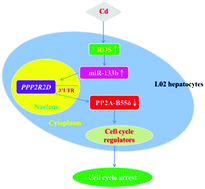Retracted Article: Cd induces G2/M cell cycle arrest by up-regulating miR-133b via directly targeting PPP2R2D in L02 hepatocytes
Abstract
Previous research has shown that cadmium (Cd), which accumulates primarily in the liver and kidneys, could cause cell cycle arrest in various cell types. In the present study, the effect of Cd on the cell cycle progression of hepatocytes and the underlying mechanisms were investigated. Our results showed that Cd inhibited the growth and proliferation of L02 hepatocytes. Further study revealed that Cd significantly induced G2-phase cell cycle arrest accompanied by an overproduction of reactive oxygen species (ROS). Cd-induced G2-phase arrest could be prevented by inhibiting ROS with the use of antioxidant Trolox. Additionally, treatment with Cd induced an increase in the expression of miR-133b, which could be reversed with Trolox pretreatment. Moreover, miR-133b was shown to regulate PPP2R2D expression by binding to the 3′-untranslated region (UTR) of PPP2R2D mRNA. We also found that treatment with Cd decreased the expression of PPP2R2D, and inhibition of PPP2R2D expression by siRNA partially aggravated Cd-induced cell cycle arrest. By artificially increasing the expression of the protein phosphatase 2A-B55δ subunit (PP2A-B55δ, encoded by the PPP2R2D gene), we confirmed that PPP2R2D can be regulated by miR-133b in Cd-treated cells, and the G2-phase arrest effect could be suppressed by PP2A-B55δ. Collectively, these findings indicated that Cd increased ROS and induced the expression of miR-133b, which consequently inhibited the expression of PPP2R2D and led to G2-phase arrest in L02 hepatocytes. This study provides novel insights into the molecular mechanisms of Cd-induced cell cycle arrest.



 Please wait while we load your content...
Please wait while we load your content...